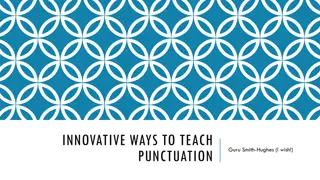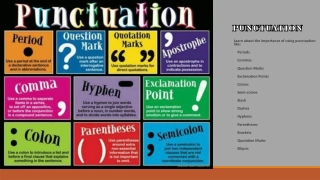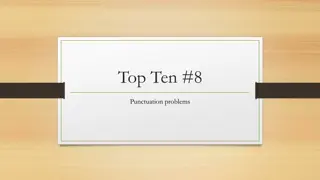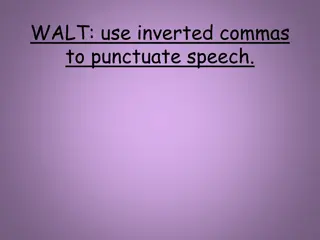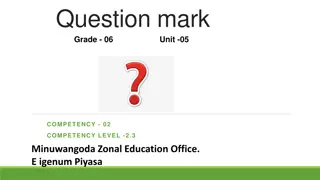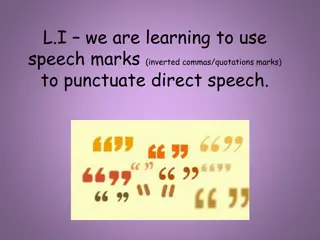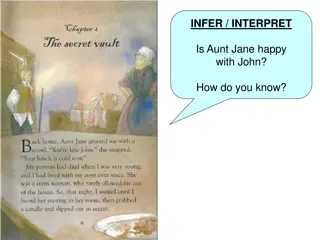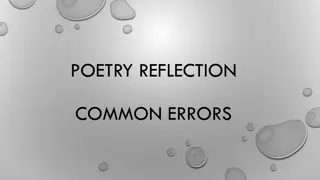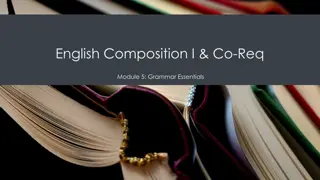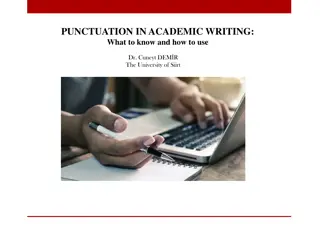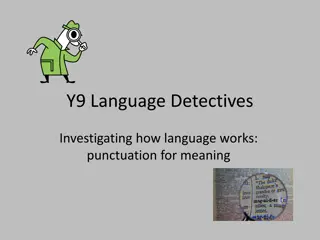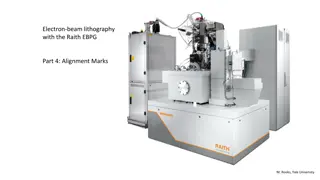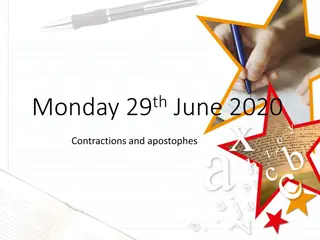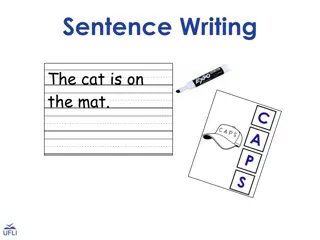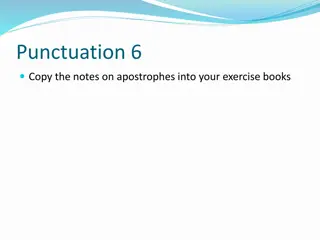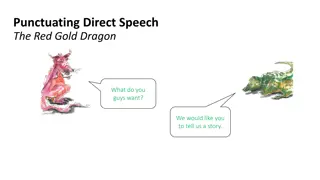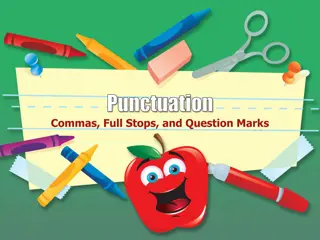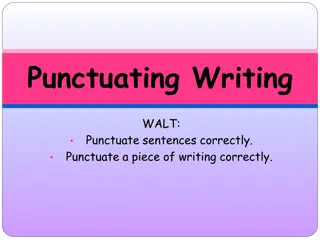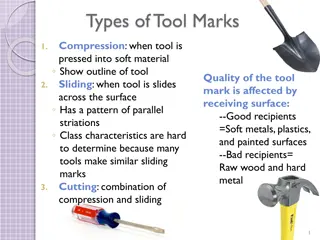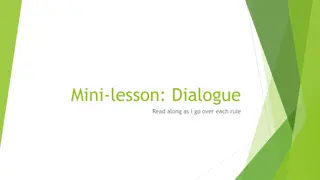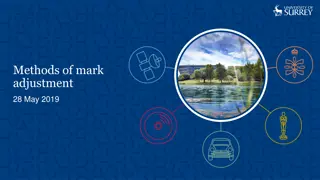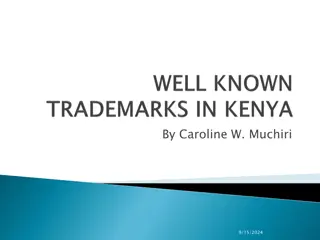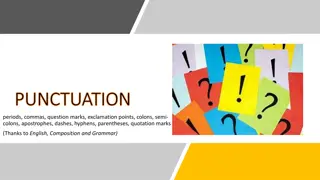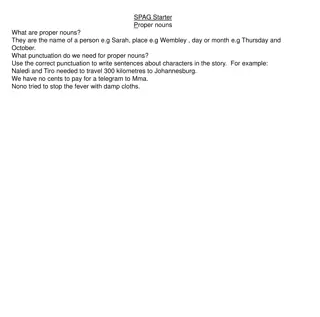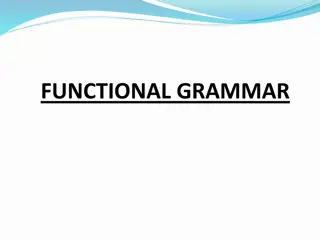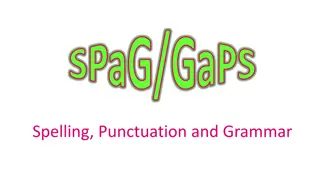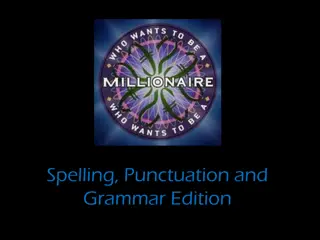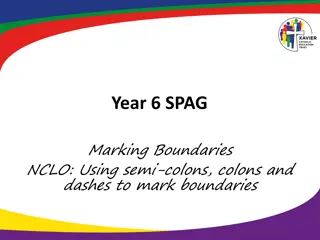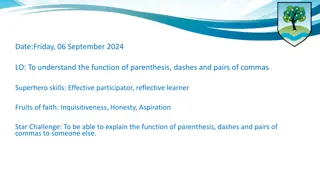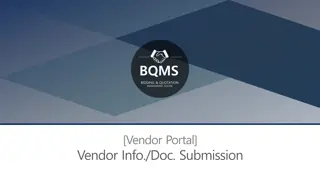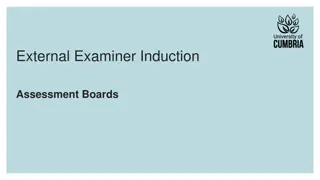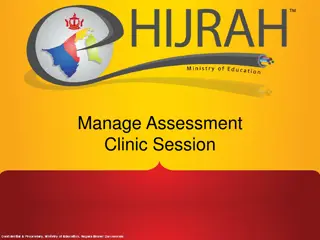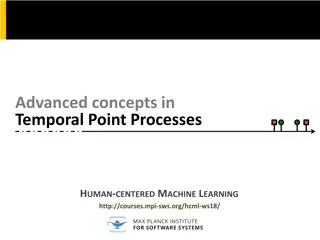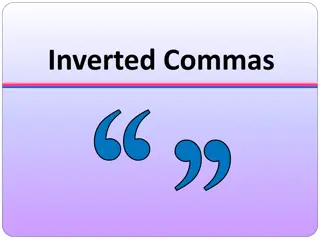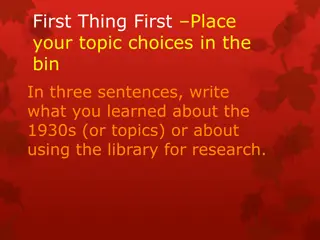Master Punctuation: Quotation Marks, Apostrophes, and More!
Explore the essential rules of using quotation marks in direct quotations, dialogue, and other contexts. Learn the mysteries of apostrophes for showing possession and omission. Enhance your punctuation skills with practical examples and guidelines presented in a clear format.
Download Presentation

Please find below an Image/Link to download the presentation.
The content on the website is provided AS IS for your information and personal use only. It may not be sold, licensed, or shared on other websites without obtaining consent from the author. Download presentation by click this link. If you encounter any issues during the download, it is possible that the publisher has removed the file from their server.
E N D
Presentation Transcript
1 The Right Way to Write 2 What Is a Sentence, Anyway? 3 Filling Out Sentence Fragments 4 Putting a Stop to Going On and On 5 Good Beginnings, Good Endings 6 Comma Sense 7 More Jobs for Commas 8 Getting Fancy with Semicolons and Colons : : 9 Controlling Quotation Marks 10 The Mysteries of Apostrophes and Dashes 11 The Finer Points of Punctuation 12 Verbs That Follow the Rules 13 Rebellious Verbs 14 Don t Be Tense about Verbs 15 Making Subjects and Verbs Agree 16 Beating the Pronoun Odds 17 Problem Verbs and Pronouns
9 - 10 ) 46 - 56 ( Lesson 9: Controlling Quotation Marks( page 46-51) Using quotation marks in direct quotations -Use double quotation marks to set off direct quotation or thought within a sentence or paragraphs. For example, the sign read, "No Smoking." -Use single quotation marks to set off a quotation within a quotation. For example, my doctor always says, "take my wife's advice: 'If it tastes good, it has to be fattening! USING QUOTATION MARKS IN DIALOGUE -Using it in dialogue for example, "I'm really hungry. I want something to eat, "said Harry. -Use it to indicate irony or raised eyebrows. For example, my yearly "evaluation" involved a three-minute conversation with the boss. Other Uses for quotation marks Italics instead of quotation marks: words as words: the word food always brought a smile to his face. Emphasis: I have never seen anyone so fond of music Practice (the answer) ( See the book page 50) 1- "Do you ever watch 'CSI' ON CBS?" asked Steven. 2-"which one of you called me a 'cowardly excuse for a soldier'? "barked the sergeant. 3-After reading to kill a Mockingbird, I rented the movie.
Lesson 10 (page 52-56 The Mysteries of Apostrophes and Dashes Using Apostrophes to Show Possession Apostrophes are used to show that one or more things belong to one or more people or things. Apostrophes are often used because they shorten sentences, meaning fewer words for the reader. APOSTROPHES See book page 52-55 Using Apostrophes to Show Possession See page 52 The following sets of examples illustrate this: These books belong to the girl. These are the girl's books. Add s to singular words not ending in s. E.g.cat s toy , queen s throne Add s to singular words ending in s. American Express s advertising Add s to plural words ending in s. E.g. girls bicycles Add s to plural words not ending in s. E.g.men s shoes -people selection When a common or proper noun is more than one word, special rules apply.Usually,you add the s to the last word in the noun Add s to the last word of a compound noun. E.g. mother-in-law s visit Add s to the last name meossession. E.g. two cents worth ntioned if a single item belongs to more than one person. Wayne and Judy s log home Add an apostrophe to words showing periods of time if they show possession. one day s schedule e.g. one year s salary Add an apostrophe to words showing amounts of money if they show
Using Apostrophes to Show Omission Use an apostrophe to show that letters or numbers have been omitted. E.g. Becky doesn t (does not) work today When Not to Use Apostrophes Do not use an apostrophe to form a plural,but only to show possession for either singular or plural words. Wrong: Get the tomatoe s from the garden. Correct: Trim the tomatoes lower limbs. DASHES See book page 55-56 A dash is a specialized punctuation mark reserved for only a few types ofsituations.However,many writers use it incorrectly.Dashes call attention to themselves. Because ofthis,a careful writer uses them sparingly.They are very effective ifused correctly,but they lose their impact if they are overused. Use a dash to mark a sudden break in thought or to insert a comment. Take these files and this Look out for that truck! I remember the day what teenager doesn t that the space shuttle exploded. Abby is delighted as we are about your new job. Use a dash to emphasize explanatory material.You don t have to use a dash, but you may. Realizing your limitations time,money,and energy makes planning more realistic. He lit a cigarette inside the building an unconscious habit. GRAMMAR IQ QUIZ Add apostrophes and dashes wherever they are needed in the following sentences. 1-The manager evaluated the sales associates performance. .1
2. The fine equaled two weeks pay. 3. Owen isnt scheduled to work today .3 Answers 1. The manager evaluated the sales associate s performance.(apostrophe shows possession) 2. The fine equaled two weeks pay.(shows possession) 3. Owen isn t scheduled to work today.(apostrophe denotes a contraction) Add apostrophes and dashes wherever they are needed in the following sentences. 1-The manager evaluated the sales associates performance. .2 2. The fine equaled two weeks pay. .3 3. Owen isnt scheduled to work today .4 Answers 1. The manager evaluated the sales associate s performance.(apostrophe shows possession) 2. The fine equaled two weeks pay.(shows possession) 3. Owen isn t scheduled to work today.(apostrophe denotes a contraction) .1 .2 .4 .5 .6 .1 .5 .6 .7
) 57 ( 68 - 12 - 11 Lesson 11 (page 57-61) The Finer Points of Punctuation Hyphens See Book Page 57-60 The main purpose ofa hyphen is to join words to create a compound word,which is a combination of words used as one word. Compound words may be written in three ways:as a single word,as two words,or as a hyphenated word.Whenever you are in doubt,consult a recent dictionary. Two-Word Compound Nouns: couch potato Hyphenated Compound Nouns :father-in-law, mayor-elect Single-Word Compound Nouns: driveway Use a hyphen to join two words working together as one. For example:Mark is a singer-dancer. Use a hyphen to join more than two words into a single word. know-it-all Use a hyphen to write two-word numbers between 21 and 99 as words. seventy-two \thirty-four \ninety-nine Use a hyphen to join fractions written as words. one-half\ three-fourths Use a hyphen to join numbers to words used as a single adjective. four-year loan Use a hyphen to separate a word between syllables at the end of a line. Here are a few guidelines for dividing words: Never leave a single-letter syllable on a line.
Parentheses See book page 60-61Practice Add hyphens where they are needed in the following sentences; 1. After examining your brain X- rays, I see little justification for you to act like a know- it -all. 2. Linda May, now an ex- corporate lawyer, re-evaluated her career goals and became a self- help author. 3. Eileen s well -researched presentation impressed the audience of twenty- five. Use parentheses to enclose explanations that interrupt the normal flow of the sentence and are only marginally related to the text. Note: Parentheses are often interchangeable with dashes in this kind of sentence. For example Center Street (a party neighborhood if there ever was one) is a great place to live. Use parentheses to enclose information when accuracy is essential. The twin children of the deceased couple (Alma and Otto Priggi) requested an autopsy. NUMBERS See book page 61 In newspaper writing , figures, or numerals, are used instead of words because they are easier to identify and read. However, a number at the beginning of a sentence is always written as a word. Use Arabic numerals (1,2,25) rather than Roman numerals (I,II,XXV). Always write a number at the beginning of sentence as a word even if it is more than two words. One hundred twenty-five employees received year-end bonuses. practice(the answer) 6-Our new four-wheel-drive vehicle (I have never liked Jeeps) is in the shop again. 7- Sugar Ray Leonard (what kind of name is Sugar ?) fought his way out of retirement several times. 8- On delivery, the recipient will pay the agreed-on fee ($435.67).
(57-68) Lesson 12: VERBS THAT FOLLOW THE RULES Verbs have four principal parts, or fundamental forms that are used to create a tense: present, present participle, past , and past participle. Present: This refers to something that is existing or happening now,or to an action that happens routinely. I walk my dog every day. Thomas is here already. As soon as my mom wakes up, she goes straight into the kitchen to make a pot of coffee. Present participle: This is formed by adding ing to the end of regular verbs. It is used with forms of the verb to be, such as am,is,are, was, or were. The present participle form of a verb expresses an ongoing action.(The helping verbs are used with the present participle determine tense, which is covered in Chapter 14.) I am looking for the notebook I lost in yesterday's class. Past: This form of a verb is used to indicate that something has already been completed. I hired my assistant because his resume was impeccable. He learned Japanese during his semester abroad in Tokyo. They placed their trust in the new counselor. Past participle: This is formed by adding -d or -ed to the end of regular verbs. It is used with the helping verb have (has, have, or had). I have learned a thing or two in my life. She has noticed his weight gain 12
REGULAR VERBS Regular verbs follow a standard set of rules for forming their present participle and past forms. The present participle is formed by adding-ing.If the verb ends with the letter e,drop the e before adding-ing.The past is formed by adding-ed.If the verb ends with the letter e, just add d. link: present form linking: forms the present participle by adding -ing linked: forms the past and past participle by adding -ed prepare: present form preparing: forms the present participle by dropping theeand adding-ing. prepared:forms the past and past participle by adding d. Practice 1(the answer) 1.Paul defined the word impetus for us. 3.The snow melted early this year. 2.Water is leaked through the roof. / 67 / 66 / 65 / 64
-75) 80 Chapter 13: Rebellious Verbs (69-75) - ( 14 13 Most verbIrregular verb a verb that forms its past and past participle forms in a unique way s in the English language are regular IRREGULAR VERBS WITH SIMILAR PAST AND PAST 70 PARTICIPLE FORMS Practice 2 1. The dentist (asked) me to (bite) down hard on the X-ray tabs. 2. Dark-colored garments (bleed) freely in hot water. 3. I (heard) yesterday that you plan to move before summer. 4. Will (paid) his bills with a credit card. M o r e i r r e g u l a r v e r b s w i t h tw o id e n t i c a l IRREGULAR VERBS WITH THREE DISTINCT FROMS 72 MORE THREE-PART IRREGULAR VERBS --- 71 74 - 73
Aint (See page 74) Ain tis a substandard English word that should never be used in business language. It belongs in the same category as wanna and gonna.You may hear these words when people speak,but they are not used in formal writing.Instead of ain t,use is not or isn t,am not, and are not or aren t. Incorrect: I ain t interested in your product. Correct: I am not interested in your product. Incorrect: He ain t the problem here. Correct: He isn t the problem here. Incorrect :We ain t supposed to know about the party. Correct :We aren t supposed to know about the party. CHAPTER 13 GRAMMAR IQ QUIZ 1. The teacher (asked) the student a question. 2. Life (dealt) me a good hand. 3. The plumbers (did) a good job of stopping the leak. 4. The lake will (freeze) over by morning.
-76) English Grammar Page 76-88 (ch.14 ) Don t be tense about verbs 8( 8 14 KEEPING VERB TENSE CONSISTENT The tense of a verb tells when an action occurs, occurred,or will occur. Verbs have three basic tenses: present,past,and future. A passage that begins in present tense should continue in present tense. If it begins in past tense,it should stay in past tense. Wrong :The officer unlocked the trunk and searches for contraband. Correct:The officer unlocked the trunk and searched for contraband. Correct:The officer unlocks the trunk and searches for contraband. IMPROPER USE OF PAST TENSE Don t use past tense to make a statement about a present condition. Zelda met the new director. He was very tall.[Isn t he still tall?] Zelda met the new director. He is very tall. 78 - 77 ESENT TENSE FOR STATEMENTS OF GENERAL TRUTH OR FACT Even if a passage is written in past tense, a general statement of truth or fact is written in present tense. During Galileo s time ,few people believed (past) that the earth revolves (present) around the sun. The engineer explained (past) to the city council that the streets run (present) parallel to the freeway. IMPROPER USE OF PAST TE NSE Don t use past tense to make a statement about a present condition. 79 SUBJUNCTIVE MOOD FOR CONDITIONS CONTRARY TO FACT 79 Practice 1(the answer) 1. After Ethel knocked on the door, she ( rang) the doorbell. 2. By the time I get on the plane, she will (have read) my love letter. 3. My teacher explained why Mars (is) red. 4. I would finish the job if I (were) you.
Chapter 15 (page 81-88) MAKING SUBJECTS AGREE WITH THEIR VERBS IN NUMBER ( 81 - 94 ( 16 - 15 See Page 82 A subject should agree with its verb in number. In other words, if a subject is singular, the verb must be singular; if the subject is plural, the verb must be plural. He _____.[singular] They _____.[plural] Problem Verb Forms and Constructions The verb form to be be, am, is, are, was, were can pose special problems because the principal parts are formed in such unusual ways. The following list shows how to use the verb form to be. See Page 82 Phrases Following Subjects Don t Affect Verbs See Page 83 Pay careful attention to the subject in a sentence. Do not allow a phrase following it to mislead you into using a verb that does not agree with the subject. The subjects and verbs are in bold in the following examples. One of the chairs is damaged. The window designs by Rick Baker are complex and colorful Special Singular Subjects Some nouns are singular even though they end ins. Despite that they sound plural, they require a singular verb because we think of them as a single unit. Most of the nouns in the following list are singular. Some can be either singular or plural, depending on their use in the sentence.
These are just a few examples: measles, mumps,news,checkers or marbles (games),physics,economics ,mathematics, civics, athletics,sports,politics, statistics. The news is over at 9:30. Darts is my favorite game. Sports is a healthy stress reliever. Low-impact a erobics is best for older adults. MAKING PRONOUN SUBJECTS MATCH THEIR VERBS IN NUMBER See Page 84 A pronoun is a word that takes the place of a noun. For example, in thissentence, All of the cookies were decorated, the word all stands for or refers to cookies, and acts as the subject. Singular Pronouns These pronouns are always singular.They require singular verbs. Each/ anyone/ nobody /either/ everybody/ one /neither /everyone /somebody/ anybody/ no one /someone See how these pronouns take singular verbs in the following examples: Someone always forgets to sign in. Neither child wants to miss the fireworks. Each of the members feels that an increase in dues is justified. Everybody here thinks the car should be fixed instead of traded in for a new model. Plural Pronouns See Page 85 The following pronouns can be either singular or plural: all none- any- some -most The words that these pronouns refer to determine whether the verbs are singular or plural. If the pronoun refers to a plural noun or pronoun, the verb must be plural. If the pronoun refers to a singular noun or pronoun, the verb must be singular.
Plural Pronouns Singular/Plural Pronouns See Page 85 Singular Plural All of the work is planned. All of the jobs are planned. Is any of the pie remaining? Are any of the pieces remaining? Most of the milk was sour. Most of the glasses of milk were empty. None of the time was spent None of the hours were spent very well. Some of the fruit was shipped. Some of the apples were shipped COMPOUND SUBJECTS See Page 86 A compound subject is made up of two or more subjects that are joined by a conjunction (usually and, or, or nor) and that share the same verb. VERBS AGREE WITH SUBJECTS, NOT THE WORD FOLLOWING THE VERB See Page 87 WHEN THE SUBJECT FOLLOWS THE VERB See Page 87 Practice 3(the answer) 17. None of these keys (unlocks) the back door. 18. Each of the project components (take) several hours to complete. 19. All of the box lunches (have) been given away. 20. Some of the animals (were) moved for the winter.
(ch.16-17) Page .(89-95) Beating the pronoun odds PRONOUNS AND ANTECEDENTS See Page 89 A pronoun is a word that takes the place ofa noun or another pronoun.The noun represented by a pronoun is called its antecedent.The wordantemeans before, and cede means come. So the literal meaning of antecedent is comes before. Usually,the antecedent comes before the pronoun in a sentence.For example The state employees received their benefits. Erica thought she saw the stolen van and reported it to the authorities Indefinite Pronoun Antecedents See Page 89 A pronoun must agree in number with its antecedent. In other words, if the antecedent is singular,the pronoun must be singular; if the antecedent is plural, the pronoun must be plural. People usually have little trouble matching a pronoun with a noun antecedent.However,sometimes a pronoun represents another pronoun.In the last chapter,you learned about singular indefinite pronouns.Remember,they are known as indefinite pronouns because they don t refer to one specific person or thing. The antecedents of singular indefinite pronouns require singular pronouns each -anyone nobody- either -everybody -one -neither -everyone somebody- anybody- no one -some
Practice 1(the answer) 1. No one in (her) right mind would follow your advice. 2. Neither the soldiers nor the sergeant was sure of (his) location. 3. Anyone who is interested in the pilot project should sign (his or her) name on this contract. 4. Ask someone in maintenance to fix this desk, and (he or she) probably will take care of it right away. PRONOUNS AS SUBJECTS AND OBJECTS See Page 91 A single pronoun in a sentence is easy to use correctly. In fact, most English speakers would readily identify the mistakes in the following sentences. NOUN-PRONOUN PAIRS See Page 92 Sometimes, a noun in a sentence is immediately preceded by a pronoun. To make sure that you use the correct pronoun, delete the noun from the pair. INCOMPLETE CONSTRUCTIONS See Page 92 Sometimes, a pronoun comes at the end of a sentence following a comparative word such as than or as. AMBIGUOUS PRONOUN REFERENCES See Page 93 Sometimes, a sentence is written in such a way that a pronoun can refer to more than one antecedent. When this happens, we say the meaning is ambiguous; that is, it can be understood in more than one way. In the following examples, the ambiguous pronouns are italicized, and the possible antecedents are underlined.
REFLEXIVE PRONOUNS See Page 93 Reflexive pronouns refer to another word that is the same individual(s) or the same thing(s).They are called reflexive because they reflect like a mirror. Reflexive pronouns include the word self or selves: myself, yourself, himself, herself, itself, ourselves, themselves. For example I drove myself to the train station. Take care of yourself. Using Reflexive Pronouns Correctly See Page 93 The possessive pronouns his and their cannot be made reflexive. Wrong: The Garrets decided to supervise the building theirselves. Correct:The Garrets decided to supervise the building themselves. Wrong: Mitchell asked to do the work hisself. Correct: Mitchell asked to do the work himself. Avoid using a reflexive pronoun when a personal pronoun works in the sentence. Wrong: A group of volunteers and myself repaired the roof. Correct:A group of volunteers and I repaired the roof.
Page .(89-95) Chapter 17 PROBLEM VERBS AND PRONOUNS (See page 95-100) PROBLEM VERBS Lie/Lay See page 95 Few people use lie and lay correctly ,perhaps because few people know the difference in meaning between the two. The verb lie means to rest or recline. The verb lay means to put or place. Lie is something you do yourself(or some person does himself or herself, or some object does itself);lay is something you do to an object. Sit/Set See page 97 Sit means to rest. Set means to put or place. Rise/Raise See page 97 The verb rise means to go up. The verb raise means to move something up. Raise requires an object. In other words, something must receive the action of the verb raise (raise your hand, raise the flag,raise the objection ,raise children). PROBLEM PRONOUNS Its/It s See page 99 Its is a possessive pronoun that means belonging to it. It s is a contraction for it is or it has. Use it s only when you can also substitute the words it is or it has.Take time to make this substitution,and you will never confuse these two words. For example The thermometer in the roast will measure its (belonging to the roast) temperature. It s (it is) time for us to say goodbye and head home. It s (it has) been three years now since I ve seen Tom
Practice 2(the answer) 15. I wonder if (its) a good idea for us to be here. 16. The wind will eventually stop (it s) howling. 17. Tell me when (its or it s) time for a break. 18. (Its) been fun to watch the dog chase (its or it s) tail Your/You re See page 99 Your is a possessive pronoun that means belonging to you. You re is a contraction for the words you are. Use you re only when you can also substitute the words you are. Who/That/Which See page 99 Who refers to people. That refers to things. Which is generally used to introduce nonessential clauses that describe things. Whose/Who s See page 99 Whose is a possessive pronoun that means belonging to whom. Who s is a contraction for the words who is or who has. Take time to make this substitution, and you will never confuse these two words. Who s (Who is) handling the funeral arrangements? Whose (belonging to whom) bright idea was that?This is the officer who s (who is) on duty tonight. That is the girl whose (belonging to whom) picture was in the paper. There/Their/They re See page 100 There is an adverb telling where an action or item is located.Theiris a possessive pronoun that shows ownership.They re is a contraction for the words they are. There (here) goes my future
Their (belonging to them) time is limited They re (they are) hoping to leave in the morning Practice 3(the answer) . (You re) likely to lose your mind in (there). 29. (They re) rearranging the shelves in the closet. 30. (It s) been a year since (their) last anniversary. 31. The landscaper (who) did the work lives over (there, their, they re). - MCQ - GOOD LUCK


